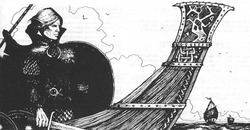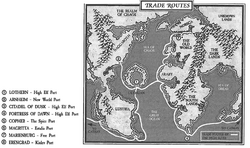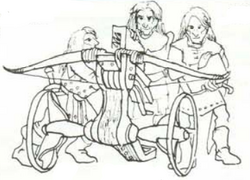"I hear the Fay themselves walk the streets of Quenelles, working wonders. That would be something to see!"
- —An ignorant tavern keeper of L'Anguille, talking to a Sea Elf wizard.[4a]

A Sea Elf of Ulthuan at the bow of his ship.
Sea Elves, called the Uranai in Eltharin[12a], are those High Elves of Ulthuan who have taken to trading with the various ports of the Old World and beyond, sometimes even living for a time within Human communities such as the great commercial seaport of Marienburg.[2a]
The term "Sea Elves" is often used by the peoples of the Old World to describe the dauntless High Elves who venture beyond the safe shores of the island-continent of Ulthuan as mariners, explorers, traders, and diplomats, and who stand in stark contrast to any grim Asur accompanying them who pursue the calling of the warrior.[2a][9a] In truth they are themselves also fearsome warriors that have shaped the balance of power in the Old World on multiple occasions.[8a][10b]
History[]
Sea Elven Commerce with Tilea[]
The Sea Elves had never completely abandoned the oceans around the Old World even though they had deserted their ancient colonies on that continent after the War of the Beard. When the tribes of Men in Tilea founded the first city-states in that region, the Elves were ready to resume contact. At the same time, Tilean trade with the Dwarfs to the east was flourishing. Most of this commerce was conducted overland.[1q]
The main concern of Tilean merchants has always been expanding their business, or, to put it bluntly, making money. Most of the more successful merchants not only attempted to secure the old trade routes, but were interested in opening up new ones. The oldest trade routes included the sea route to Ulthuan, the land route across the mountains to the Dwarf kingdoms, the extension of this route across the mountains and into the Empire, and the route across the Tilean Sea to Tobaro.[11a]
It was High Elf seafarers who re-opened the ancient trade route to their former colonies in the Old World many centuries after they had abandoned them. Here they encountered the Tileans established among the ruins of their lost cities, re-using the tumbled Elven masonry to build their own cities. The High Elves found the Tileans to be an easy people to trade with, eager to exchange all kinds of things for exotic luxuries from Ulthuan. As for the High Elves, they were interested in acquiring ancient Elven artefacts and sculptures which the Tileans found among the ruins of the Elven colonies. It was no doubt these early contacts which stimulated the Tilean taste for both art and profit.[11a]
There were also Dwarf traders coming into Tilea along the mountain roads from the east. They were eager to discover what of value was left after the Elves had finally left the Old World for good, even though Dwarf adventurers had doubtless plundered the Elven ruins even before the Tileans resettled them. Eventually the Dwarfs returned to the region and found the old cities inhabited once more, this time by Men. There were plenty of things which the Tileans were willing to buy from the Dwarf traders in exchange for gems and exotic metals obtained in trade with the High Elves: iron, copper, gold, silver and expertise in metalworking and building.[11a]
It seems likely that the wily Tileans persuaded the Dwarfs to show them how to build strong fortifications for their cities. In fact, it is a commonly-heard joke in Tilea that when Tileans combine Elven architecture with Dwarfen masonry you get a leaning tower![11a]
The Dwarfs were eager to obtain High Elven goods from Tilean middle men which the Elves themselves would certainly not trade with Dwarfs, not even for all the gold in the Worlds Edge Mountains. Similarly, the High Elves wanted precious metals and gems but the Dwarfs refused to trade with them on account of the great grudge they held. For their part, the Tileans happily traded with both and soon grew rich.[11a]
This commercial relationship brought other benefits as the value of the Tilean trade with Ulthuan grew. In 1565 IC the city-state of Tobaro was saved from a dreadful Skaven invasion by the arrival of a force of Sea Elves allied with the merchant prince Meldo Marcelli and his mercenary army, freeing the city from a siege that lasted two years.[8a]
Marienburg Treaty of Amity and Commerce[]
In 2149 IC, Wavemaster Sullandiel Fartrader proposed that rather than compete with the realms of Men for the trade with Lustria, Ulthuan should have selected one of the Human city-states or kingdoms of the Old World to trade with. Marienburg was considered the best choice for this commercial opening, leading to the signing in 2150 IC of what was known as the Treaty of Amity and Commerce. This agreement allowed the Sea Elves to establish a commercial enclave within the great Human seaport in what became known parochially as "Elftown" but was known to the High Elves as Sith Rionnasc'namishathir, formally the Continental Exarchate of the High Kingdom of Ulthuan.[7c]
As part of this relationship, the Sea Elves have also helped protect Marienburg from attack, most notably at the Battle of Grootscher Marsh, in which Marienburg finally secured its independence from the Empire in 2429 IC.[10b]
Role[]
The High Elves living around the coasts of the kingdoms of the island continent of Ulthuan have a tradition of seamanship and fighting, and lack the normal Elven disdain for physical labour. Because of this, other High Elves look down on them, thinking them rough and uncouth. They are brave warriors and tireless guardians of the seaways, and it is thanks to them that the sea routes between the Old World and Lustria remain open.
These "Sea Elves," as Old Worlders call them, are quite venturesome, and can often be found as merchants and traders in Old World ports. Most of them speak the languages of Men as well as Eltharin, and many have a smattering of the Norse language too. The Elven trading posts of the Old World are run almost exclusively by Sea Elves.[2a][5a]
Sea Elf Trading Communities[]

High Elf trade routes map
The vast majority of Elves do not live in the Old World but upon the island-continent of Ulthuan. The High Elves have long been accomplished international merchants; their ships effectively control passage through the Great Western Ocean, enabling their fleets to travel freely between Lustria, Grand Cathay, and the Old World. Most of these travelling High Elves are Sea Elves from the outer-coasts of Ulthuan, often merchants or travellers spending a year or so in the Old World before moving on to somewhere new.[1b][5a]
To facilitate their trade with Men, some Elves have settled in Old World ports, usually within an "Elvish Quarter" set aside for them by city authorities. Because the Human cities highly value Elven trade, Elvish Quarters are allowed to administer their own affairs, and are regarded as being off-limits to uninvited Humans. Many of these quarters are fortified, the High Elves serving as their own watchmen and militia.[1b]
The largest population of High Elves in the Old World is that of the "Elftown" quarter in Marienburg, less prosaically known as Sith Rionnasc'namishathir in Eltharin, where there may be as many as 500 individual High Elves at one time. While technically a part of the city, it is governed under Sea Elf law, under the authority of the Phoenix King of Ulthuan.[1b][7a][7b]
However, the Treaty of Amity and Commerce concluded by Ulthuan with Marienburg was only the beginning of the quest for new markets that the High Elves sought in the Old World. Magritta, L'Anguille, Brionne, Luccini and Erengrad all have their own Elven quarters where the High Elves govern independently and act as a hub for High Elven trade with other major ports.[11]
Recently the people of Magritta ignored the ancient agreements with Ulthuan and declared its Elvish Quarter to be sovereign Magrittan territory. The local militia marches through it at will and demands a tithe of everything the Asur trade. This precedent threatens to strain relations between Ulthuan and the Human realms of the Old World, which for their part, fear the constant influx of goods from Lustria and Grand Cathay brought by Sea Elven merchants.[11]
Every Old World port with a population of over approximately ten thousand has its own Elvish Quarter. A typical Sea Elven trading community would have a population of about one percent of the total city population. Although trading posts are sometimes maintained in smaller cities, this is rare, and often the Elven occupation is sporadic or comprised only of temporary traders coming or going, a family settling for a few years before retiring back home.[2b]
Forces of the Sea Elves[]

A Marine Bolt-Battery being armed by its crew.
Although primarily seafighters, the Sea Elves also provide most of the soldiery of the High Elves' armies and may even be found in the Old World, where small groups hire out as mercenary adventurers. Like other High Elves, they can be arrogant towards the other mortal races, and their verbose sense of humour may not endear them to the hard-witted Men or down-to-earth Dwarfs. However, they are the most outward-looking of all the Elven kindreds and the one most commonly encountered by the other mortal races.[1c]
Sea Elves do not favour the bow as do the Wood Elves, but prefer to rely upon close combat weapons. Accordingly they have never quite developed the archery skills of their brethren, although some warriors do carry bows and make good use of them.[5a]
Sea Elves, like Wood Elves, are permanently organised into local patrol groups -- which form the basis for regiments in war time. Regiments are between 12 and 16 Sea Elves in strength, cavalry between 5 and 10 Sea Elven knights.[5b]
When on the battlefield, Sea Elves favour a slow advance, hopefully backed up by archers and covered by cavalry. Because Sea Elf armies are small, they avoid remaining stationary, so their enemies cannot gang up against them.[5b]
Sea Elves frequently venture far inland and need to bring provisions and trade goods with them. This requires that their armies make use of civilians to carry their baggage train.[6a]
The natural allies of High Elves and Sea Elves are their rustic sylvan kindred from the Old and New Worlds, the Wood Elves. They have many warlike skills and unusual warriors which are sometimes requested by the lords of the High Elven kingdoms of Ulthuan.[6a]
Regimental Colours[]

Sea Elf icons
Sea Elves dress in solid, but bright colours -- especially blue, but also red, green and grey. They wear steel armour and their weapons are of keen, bright steel. Spear shafts and bows may be left as natural wood or painted in a regimental colour, which will be reproduced in the helmet plumes and shields.[5b]
Shields may be elaborately embossed or brightly painted; blue predominating but also red, green, and parti-coloured. Spears and lances have pennons in the regimental colour and the Regimental Standard are very elaborate with intricate embroidery and careful needle-work, all executed in the fastidious manner of Elves.[5b]
Notable Sea Elven Units[]
- Marine Bolt-Batteries - Marine Bolt-Batteries are detached batteries of ballistic warship armament similar to Eagle Claw Bolt Throwers, manned by expert Sea Elf crews, that may be used on land to support Elven armies. This is yet another example of how a powerful High Elven army can be mustered virtually anywhere in the Known World, thanks to the flexibility of Sea Elf forces and Elven tactical ingenuity.[6a]
- Merchant Companies - The Sea Elves have long prospered greatly from their trading, and their merchant princes maintain their own regiment of soldiers to protect their ships and havens at home and abroad. They are always well-armed and uniformed in the colorful livery of their lord. These regiments are unusual In that half the soldiers are spearmen or halberdiers, while the other half are archers.[6a]
- Sea Elf Wardancers - These small bands are valued as boarding parties in Sea Elf naval actions and are frequently to be found in their armies on land as well.[6a]
- Ships Companies - The warships and trading galleons of the Sea Elves have well-armed crews. Sometimes these warrior crews may be used to augment the Sea Elves' land forces.[6a]
Notable Sea Elves[]
- Tarmonagh din-Ciobahn - Din-Ciobahn is the current exarch of the Elftown district in Marienburg.[7a]
- Linna and Corma - Linna and Corma are two Sea Elf merchants who originated in Ulthuan and later settled in the Tilean city-state of Remas.
- Silenna Starguided - Starguided is a famed Sea Elven navigator who once charted a way through the Maw.[10a]
- Sullandiel Fartrader - Wavemaster Sullandiel Fartrader was a merchant of Clan Ulliogtha who worked to establish the first commercial relations between Ulthuan and Marienburg through the signing of the Treaty of Amity and Commerce between the High Elven kingdoms and the Human city-state.[7a]
Sources[]
- 1: Warhammer Fantasy Battles Rulebook (3rd Edition)
- 2: Warhammer Fantasy Roleplay 1st Edition: Core Rulebook (RPG)
- 3: Warhammer Fantasy Roleplay 2nd Edition: The Thousand Thrones (RPG)
- 3a: pg. 11
- 4: Warhammer Fantasy Roleplay 2nd Edition: Knights of the Grail (RPG)
- 4a: pp. 88-89
- 5: Warhammer Fantasy Roleplay 1st Edition: Forces of Fantasy (RPG)
- 6: Warhammer Fantasy Battle: Warhammer Armies (3rd Edition)
- 6a: pp. 49-51
- 7: Warhammer Fantasy Roleplay 1st Edition: Marienburg, Sold Down the River (RPG)
- 8: Warhammer Fantasy Roleplay 4th Edition: Up in Arms (RPG)
- 8a: pp. 57-60 (Tilean Timeline)
- 9: Warhammer Fantasy Roleplay 4th Edition: Core Rulebook (RPG)
- 9a: pg. 28
- 10: Warhammer Fantasy Roleplay 4th Edition: Sea of Claws (RPG)
- 11: The Voyage South (Short Story) by Nicola Griffith
- 12: Tales of Orfeo: Storm Warriors (Novel) by Brian Craig
- 12a: Ch. 3
